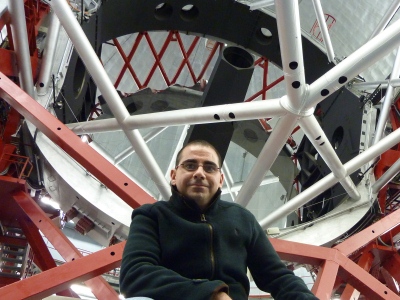Rebels with a (still unknown) cause: massive galaxies in a hierarchical Universe
Interview with Pablo G. Pérez González (UCM)
“The most massive galaxies have an accelerated behavior: they start their formation very early and evolve quickly at early epochs in the History of the Universe”
By Nayra Rodríguez Eugenio (IAC)

A challenge for current cosmological models is the existence of a numerous population of massive galaxies which not only had assembled a considerable amount of stars (1011-1013 solar masses) at an early epoch of the Universe, but were already evolving passively by that time. Pablo Pérez González, Professor at the Astrophysics Department of the Universidad Complutense de Madrid (Spain), is particularly interested in understanding how those galaxies, known as “massive quiescent galaxies”, have evolved during the lifetime of the Universe. His research is currently focused on the analysis of medium-band ultra-deep data of hundreds of such galaxies taken with the GTC within the Survey for High-z Absorption Red and Dead Sources (SHARDS).
Pérez Gonzalez has recently visited the IAC within the Severo Ochoa Senior Visitor Programme, an initiative of the IAC that aims to enhance the collaboration between the IAC staff and renowned researchers of other leading scientific institutions.
What exactly are the “massive quiescent galaxies” and how can we study them in the distant Universe?
In the nearby Universe, that is, in the region of the Universe that is close to our own Galaxy, the Milky Way, there are many galaxies as large as ours. One example is the Andromeda Galaxy. There are also many smaller galaxies, for example, the Large or the Small Magellanic Clouds (LMC and SMC). But there are also bigger galaxies, 10 times or nearly 100 times more massive than our Galaxy. One example is M87, one of the biggest galaxies known. Typically, those galaxies have elliptical morphologies and they are now “dead”. This means that they do not form stars anymore, or, in other words, they formed most of their stars in the past, and they are now in a “quiescent phase”.
One way to understand how these galaxies have formed involves studying examples of massive quiescent galaxies in the nearby Universe. But I follow an alternative route, taking advantage of one of the most important properties of nature: the speed of light. Light is our way in Astrophysics to know about other galaxies. The speed of light is enormous. Light can travel the distance from Canary Islands to Madrid in 7 milliseconds. But the speed of light is not that large when compared to distances between galaxies in the Universe. The light from one of the closest galaxies to the Milky Way, the LMC, takes 160,000 years to reach the Earth. This means that when we observe the LMC we are seeing how that galaxy looked like 160,000 years ago, when the light left the LMC. So… we can then see the past!!! (but we cannot see the “present”, we don’t know how that galaxy looks like “now”).
Having this in mind, we can think of another way to understand how massive galaxies have formed: search for distant galaxies whose properties are similar to nearby massive quiescent galaxies, or to what we expect to see when they were forming the stars that we see today. In other words, we can try to search for the progenitors of massive quiescent galaxies at different distances, and that will give us information about different epochs in their evolution. Distance in Cosmology is measured with what we call redshift, so some of us, astronomers, study galaxies at the highest redshifts possible to understand galaxy evolution from the very beginning of the Universe. The task to identify progenitors of nearby massive quiescent galaxies is not easy, and we are not only interested in finding them, but also to study all their properties and relate them to other galaxies at higher and higher redshifts. These galaxies at high redshift are very faint because they are very far away (and because they might be smaller), so we need large telescopes such as the GTC to be able to see and study them.
Why are high-redshift massive quiescent galaxies a challenge for current cosmological models?
We think that most galaxies in the Universe form in a way that we call “hierarchical”. What is this? To understand the hierarchical formation models, we have to know that galaxies consist, in a large proportion, of dark matter, and that dark matter forms halos. The physics that governs dark matter halos is (most probably) well understood, it is mostly gravity, something studied for centuries, so we know that dark matter halos behave hierarchically. This means that small halos gravitationally attract other halos and merge together to form larger ones. Dark matter also attracts regular matter, what we call baryons, and those baryons are the stuff that forms stars. Concerning galaxies, our models establish that small galaxies with a few million stars are formed first (in small dark matter halos). Then small galaxies merge together to give bigger galaxies. This means that in order to form a very big galaxy such as a nearby massive galaxy, you have to add many small galaxies and that takes time. So, according to current cosmological models, forming a massive galaxy such as M87 takes most of the lifetime of the Universe and many galaxy mergers. This also means that we should not see very massive galaxies at very long distances (this means very early in the lifetime of the Universe). And we should see a lot of galaxy mergers. We actually see many mergers of galaxies, and these events are more common at higher redshifts. But, puzzlingly, more than a decade ago we discovered many massive galaxies that were already formed when the Universe was very young (one third of today’s age). And, even more amazing and challenging to our idea of how massive galaxies form, some of those high redshift massive galaxies were already dead, which means that they must have formed their stars much earlier. This is a behavior that some people call “anti-hierarchical”, and it is indeed a challenge for our current paradigm of galaxy formation. We also sometimes say that massive galaxies form following a “downsizing scenario”, which means that the most massive galaxies form first (and probably very rapidly), and less massive galaxies start their formation later and/or take longer to assemble.
What is SHARDS finding about these red galaxies?
SHARDS is a project conceived to search for the progenitors of massive quiescent galaxies up to when the Universe age was just 20% of today’s, and study their properties in the most detailed way ever attempted. Before SHARDS, typically we had information about how these galaxies emit in 4-5 photometric bands in the optical. With these data, we could measure whether these galaxies were very blue, which is what you would expect if they had young stars, or red, if they had evolved stars. With those 4-5 optical bands we could also understand more properties about their stellar content. SHARDS has obtained data in 25 bands instead of just 4-5, so we have much more detailed information about the stars in massive quiescent galaxies at high redshift.
We are starting to analyze the SHARDS data and our preliminary results point out that massive galaxies do indeed evolve anti-hierarchically from a general point of view. But we have found that the most massive galaxies, although they start their formation earlier, they also take longer to assemble. This could be regarded as a hierarchical behavior but that is accelerated for the most massive galaxies in comparison with smaller systems. This accelerated behavior makes them start their formation very early and evolve quickly at early epochs in the History of the Universe, and then die soon and evolve more passively.
With the advent of 10-m class telescopes, such as GTC, the current and new instrumentation under way, we are living an exciting time for studies of how distant galaxies form and evolve. What are the key questions on this topic that are likely to be answered in the coming years?
One of the most relevant properties that we still don’t know with enough certainty is the timescale taken by galaxies of different types to form their stars. And another one is when exactly they started forming stars. In other words, we still need to obtain reliable measurements of when the formation of galaxies of different types started and how long they took to form their stars. Of course, these properties are related to the structure of the galaxies and the Universe itself. More specifically, for understanding the formation of massive galaxies, knowing that very massive galaxies were already formed at high redshift, how long before they started to form their stars? How long does it take for these galaxies to “die” (to stop forming stars)? Why do they stop forming stars? Why is their evolution anti-hierarchical while the evolution of the dark matter halos and other galaxies is hierarchical? Is there something else about dark matter that we don’t understand? Or is it just that we don’t understand the physics of regular matter and how this transforms into stars, especially in massive galaxies?
What are your impressions about the Severo Ochoa Senior Visitor Program?
This program is extremely useful. Nowadays we have very advanced means to communicate with people living far from us, even in other continents. We can use internet-based programs to talk to collaborators or we can make videoconferences with them, and these communication links are relatively cheap. However, it is sometimes quite hard to collaborate in this way given the time differences between scientists working in different countries around the world. In any case, the most effective way to work together with other people (scientists or other professionals) is still sitting in front of each other for a few days or weeks and devoting all your brain, skills, and working hours to solving a problem in collaboration with other people. The key is that 2 or more brains thinking together about the same problem work much better than a few isolated individuals, and that face to face scientific discussion is more dynamic and fruitful. In this sense, devoting funds to invite other researchers to a top institution such as IAC is extremely useful for both IAC and invited researchers. The Severo Ochoa senior visitor program has indeed been a great opportunity for me to travel to IAC and advance in a few on-going scientific projects in collaboration with several IAC researchers.


